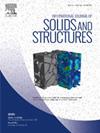Effect of phason on adhesion behavior of one-dimensional hexagonal quasicrystal
IF 3.4
3区 工程技术
Q1 MECHANICS
International Journal of Solids and Structures
Pub Date : 2024-12-12
DOI:10.1016/j.ijsolstr.2024.113193
引用次数: 0
Abstract
Different from traditional crystals, the elastic behavior of quasicrystals (QCs) is described by both phonon and phason fields. As an additional energy dissipation channel, it is significant to research how the phason affects the adhesive contact or whether it can adjust the adhesion behavior in QCs. Based on the classical Johnson–Kendall–Roberts (JKR) model and Maugis–Dugdale (M−D) model, this paper establishes the adhesive contact theories of a one-dimensional (1D) hexagonal QC half-space indented by a conical punch. By applying the superposition principle and the Griffith energy balance criterion, the significant adhesive contact physical quantities such as distributions of the normal stresses and displacements at the surface, energy release rate, indentation depth, contact radius, pull-out force, and indentation loading for both adhesive contact models are obtained analytically. Combined with related experiment, the analytical solutions of this paper are verified. The numerical results indicate that the influence of the phason field can be ignored in the JKR model when there is no initial phason displacement, whereas it is pronounced in the M−D model particularly when the contact radius falls within a small range. Furthermore, it is found that not only the adhesive behavior of 1D hexagonal QC can be controlled by changing the cone angle of the conical punch, but the initial phason displacement can also affect the adhesive contact. Overall, the findings presented in this paper offer theoretical support for the adhesion experiments of QCs and provide valuable insights for designing smart adhesive materials.
求助全文
约1分钟内获得全文
求助全文
来源期刊
CiteScore
6.70
自引率
8.30%
发文量
405
审稿时长
70 days
期刊介绍:
The International Journal of Solids and Structures has as its objective the publication and dissemination of original research in Mechanics of Solids and Structures as a field of Applied Science and Engineering. It fosters thus the exchange of ideas among workers in different parts of the world and also among workers who emphasize different aspects of the foundations and applications of the field.
Standing as it does at the cross-roads of Materials Science, Life Sciences, Mathematics, Physics and Engineering Design, the Mechanics of Solids and Structures is experiencing considerable growth as a result of recent technological advances. The Journal, by providing an international medium of communication, is encouraging this growth and is encompassing all aspects of the field from the more classical problems of structural analysis to mechanics of solids continually interacting with other media and including fracture, flow, wave propagation, heat transfer, thermal effects in solids, optimum design methods, model analysis, structural topology and numerical techniques. Interest extends to both inorganic and organic solids and structures.

 求助内容:
求助内容: 应助结果提醒方式:
应助结果提醒方式:


